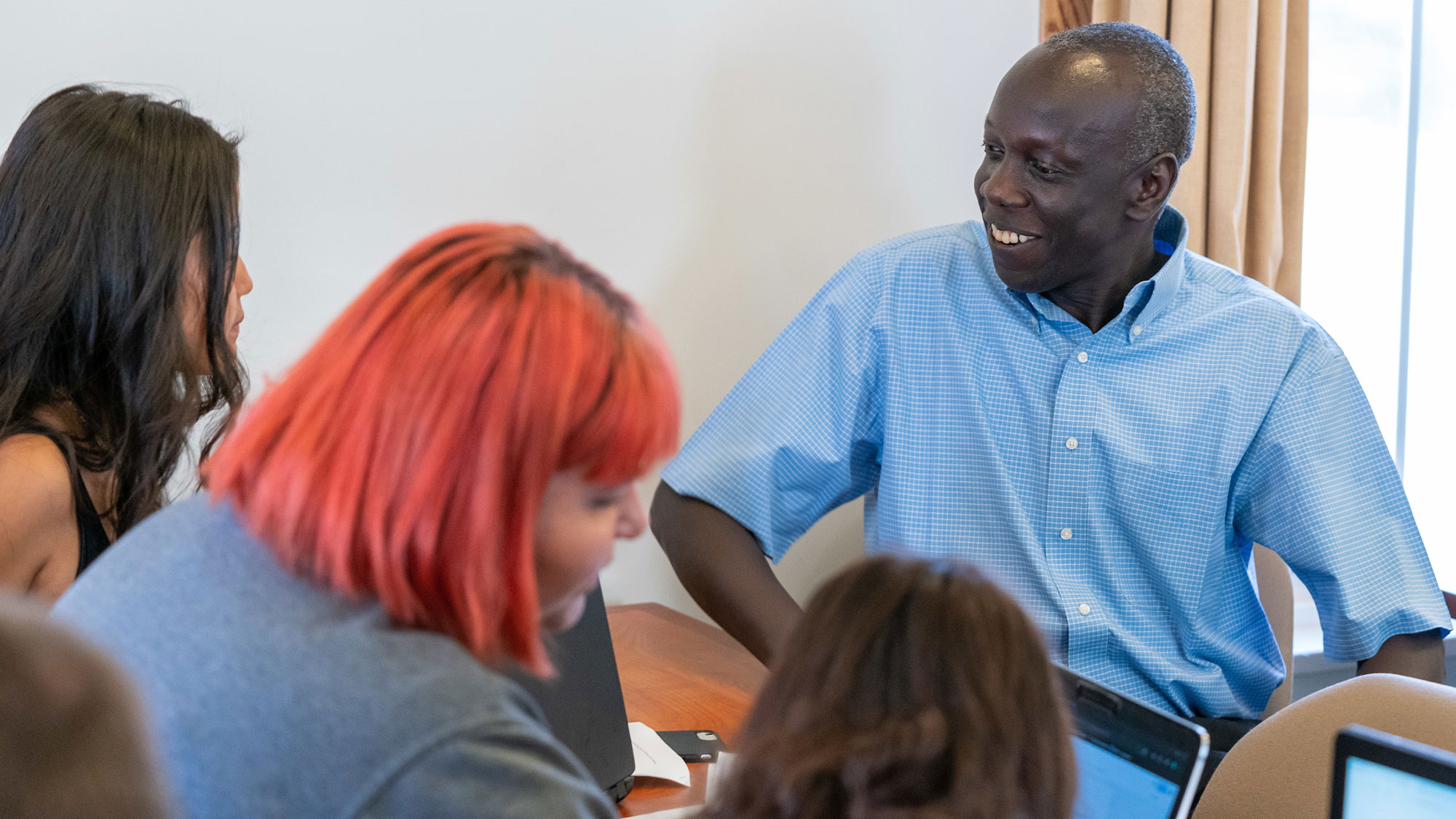
PHOTO CREDIT: Dave Titensor/University of Utah
Tino Nyawelo helps students in the REFUGES Summer Bridge Program cohort of 2018.
Download Full-Res ImageRefugee youth are particularly vulnerable to being disenfranchised from science, technology, engineering and mathematics (STEM). The National Science Foundation has awarded University of Utah and Utah State University researchers $1.1 million over three years to study how refugee teenagers construct self-identities related to STEM across settings, such as physics research and creating digital stories, across relationships, such as peer, parent, and teacher, and across the languages they speak. The first-of-its-kind project is titled “Investigating the development of STEM-positive identities of refugee teens in a physics out-of-school time experience.”
“Refugee youth often encounter many challenges related to STEM including restricted exposure to STEM education, language barriers, cultural adjustments, and a history of interrupted schooling, resulting in a low rate of high school completion and college matriculation among refugee students,” said Tino Nyawelo, associate professor of physics and astronomy and director of diversity and recruitment at the Center for Science and Mathematics Education (CSME) at the U. “The project will conduct research to better understand these challenges and how to best broaden access to and engagement of STEM for refugee youth and other historically disenfranchised populations.”

PHOTO CREDIT: Utah State University
Sarah Braden, assistant professor of Language Education & Cultural Studies at USU.
Download Full-Res ImageA cohort of nearly 30 teens will learn the principles of physics and computer programming by building detectors for cosmic rays, which are extremely energetic particles that are constantly bombarding the Earth and creating showers of secondary particles when they collide with the atmosphere. The project is embedded within Refugees Exploring the Foundations of Undergraduate Education In Science (REFUGES), an after school program that Nyawelo founded in 2009 to help refugee students in middle and high school thrive in STEM subjects. The U’s CSME has housed REFUGES since 2012 where it has expanded to include a summer bridge program for incoming first-year students at the U, and non-refugee students who are underrepresented in STEM fields.
“With REFUGES, we provide services to get students engaged with STEM. Now, we’re entering the next big phase of the program to research how to make engagement better,” Nyawlo said.
The co-principle investigators—U physicists Nyawelo, Jordan Gerton, and John Matthews and USU linguist Sarah Braden—are developing a curriculum that builds from the students’ home languages and cultures. Throughout the three-year program, the researchers will document individual students’ pathways of identification (identity development) with STEM as it unfolds in real-time, through students’ in-the-moment conversations while conducting cosmic ray research, during self-reflective tasks, and with their families during community STEM events. This moment-to-moment data will be examined with personal narratives that students craft through autoethnography culminating in digital stories.
“We know it’s not a lack of skill or interest that keeps historically underrepresented students from pursuing STEM fields. Inequity is the result of an accumulation of small moments that makes that student feel excluded from identifying with STEM,” said Braden, assistant professor of Language Education & Cultural Studies at USU. “By understanding how these inequities unfold, the goal is to then feed that information back into designing a learning environment that produces an equitable outcome.”
Building detectors and evidence-based curriculum

PHOTO CREDIT: University of Utah
John Matthews, runs the U’s Telescope Array cosmic array project in Delta, Utah.
Download Full-Res ImageCosmic ray particles hit the Earth’s surface so frequently that two rays pass through your head every second. As they zoom through the atmosphere, they crash into nuclei, creating a shower of secondary particles that cosmic ray devices can detect. The students will run their detectors from a state-owned building in Salt Lake City to collect data for research.
The detector technology is adapted from HiSPARC (High School Project on Astrophysics Research with Cosmics), a collaboration between science institutions that started in the Netherlands, aimed at improving Dutch high schoolers’ interest in particle physics. Now there are more than 140 student-built detectors on buildings in the Netherlands, Namibia, and the United Kingdom that upload their data 24/7 to a publicly-available database at the Nikhef Institute in Amsterdam. The U’s detectors will be the newest addition to the HiSPARC project.
“Once you run these detectors, you’ll be able to figure out where the showers came from, or do atmospheric studies like how pressure impacts the rates of cosmic rays arriving to the surface,” said Matthews, who runs the U’s Telescope Array cosmic array project in Delta, Utah. “Hopefully, they’ll learn something about equipment and the scientific process, and have fun at the same time.”
The researchers have spent months developing the deliberative, evidence-based curriculum that they will adapt as they get feedback from the students. Each scientist brings their expertise in physics, astronomical computing, and applied linguistics to build the unique program that will reverberate well past Utah.

PHOTO CREDIT: Dave Titensor/University of Utah
Jordan Gerton, associate professor of physics and director of CSME.
Download Full-Res Image“We’re trying to understand how to best serve students that have been historically excluded from higher ed and from STEM,” said Gerton, associate professor of physics and astronomy and director of CSME. “What can universities do to engage those students, prepare them, motivate them, make them feel welcome, help them envision themselves as scientists before they get there.”
“This exceptional research project is a great example of our goal to broaden and strengthen equity, diversity, and inclusion research efforts at the U,” said Andy Weyrich, vice president for research at the U. “We’re very excited to receive this NSF grant and look forward to the positive impact it will have in our underrepresented communities and beyond.”
